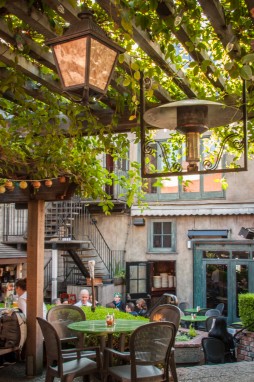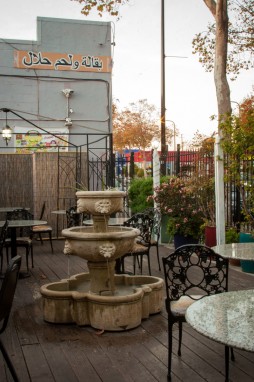
When it comes to great urban design, it’s often not about what you build, it’s about how you use what you already have. Distinct character is hard to replicate; reclaiming space around your business and reusing it in a creative way can add value to a property with minimal expenditure.
Jupiter, a popular Berkeley beerhouse located in an old livery stable from the late 1800s, makes use of the courtyard it shares with several other businesses. The two-level space is surrounded by original buildings and decorated with a large ivy-covered trellis, a fire pit, and strings of lights.
“A big part of walkability is having something that people want to slow down and take a look at—it’s being part of an experience,” says Opticos associate John Miki. “Converting unused spaces, even a tiny 10 by 10 backyard, adds visual interest to a neighborhood business district and contributes to walkability.”
Reuse is sustainable and adds value to the community. During a recent visioning charrette held in Vallejo, Opticos designers showed participants what their city could look like with only a few incremental changes. “The reuse of existing buildings and lots is an “easy” first step toward incremental change. It offers new opportunity for local and small businesses by attracting new interest to the community,” said Miki.
Determining whether an empty space is a good candidate for reclaiming is a pretty straightforward matter—if the space is there, use it. However, some spaces are better candidates than others. “Having a sense of enclosure is a key when considering whether or not to convert a space,” said Opticos designer Melia West.

If a space is contained by other buildings, providing a buffer from noise and wind, it’s more likely that people will want to sit there. “Of course, any space can be converted, but without a natural sense of enclosure, it takes a little extra effort to make a space successful,” West added.
When converting a space, keeping it simple is often the best strategy. A reclaimed space may evolve over its lifetime, but don’t try to do too much at once.
An empty parking lot behind Slow, a lunch spot on University Ave., was converted into a popular patio (pictured above). While the space is fairly large, it is surrounded by buildings on all four sides, and accessed through the café and through an iron gate. The addition of a rose garden and umbrella-covered picnic tables, along with an ample amount of afternoon sun, make it an inviting place to pass a few hours.
The takeaway? If you reclaim it, they will come. Make use of empty alleys, courtyards, backyards, sideyards, and parking lots to add value to your business and your community.
Like this article? How about these: